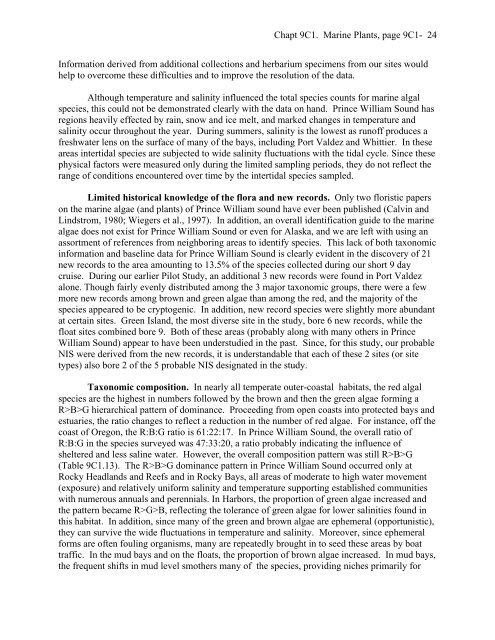Biological Invasions of Cold-Water Coastal Ecosystems - Aquatic ...
Biological Invasions of Cold-Water Coastal Ecosystems - Aquatic ...
Biological Invasions of Cold-Water Coastal Ecosystems - Aquatic ...
Create successful ePaper yourself
Turn your PDF publications into a flip-book with our unique Google optimized e-Paper software.
Chapt 9C1. Marine Plants, page 9C1- 24<br />
Information derived from additional collections and herbarium specimens from our sites would<br />
help to overcome these difficulties and to improve the resolution <strong>of</strong> the data.<br />
Although temperature and salinity influenced the total species counts for marine algal<br />
species, this could not be demonstrated clearly with the data on hand. Prince William Sound has<br />
regions heavily effected by rain, snow and ice melt, and marked changes in temperature and<br />
salinity occur throughout the year. During summers, salinity is the lowest as run<strong>of</strong>f produces a<br />
freshwater lens on the surface <strong>of</strong> many <strong>of</strong> the bays, including Port Valdez and Whittier. In these<br />
areas intertidal species are subjected to wide salinity fluctuations with the tidal cycle. Since these<br />
physical factors were measured only during the limited sampling periods, they do not reflect the<br />
range <strong>of</strong> conditions encountered over time by the intertidal species sampled.<br />
Limited historical knowledge <strong>of</strong> the flora and new records. Only two floristic papers<br />
on the marine algae (and plants) <strong>of</strong> Prince William sound have ever been published (Calvin and<br />
Lindstrom, 1980; Wiegers et al., 1997). In addition, an overall identification guide to the marine<br />
algae does not exist for Prince William Sound or even for Alaska, and we are left with using an<br />
assortment <strong>of</strong> references from neighboring areas to identify species. This lack <strong>of</strong> both taxonomic<br />
information and baseline data for Prince William Sound is clearly evident in the discovery <strong>of</strong> 21<br />
new records to the area amounting to 13.5% <strong>of</strong> the species collected during our short 9 day<br />
cruise. During our earlier Pilot Study, an additional 3 new records were found in Port Valdez<br />
alone. Though fairly evenly distributed among the 3 major taxonomic groups, there were a few<br />
more new records among brown and green algae than among the red, and the majority <strong>of</strong> the<br />
species appeared to be cryptogenic. In addition, new record species were slightly more abundant<br />
at certain sites. Green Island, the most diverse site in the study, bore 6 new records, while the<br />
float sites combined bore 9. Both <strong>of</strong> these areas (probably along with many others in Prince<br />
William Sound) appear to have been understudied in the past. Since, for this study, our probable<br />
NIS were derived from the new records, it is understandable that each <strong>of</strong> these 2 sites (or site<br />
types) also bore 2 <strong>of</strong> the 5 probable NIS designated in the study.<br />
Taxonomic composition. In nearly all temperate outer-coastal habitats, the red algal<br />
species are the highest in numbers followed by the brown and then the green algae forming a<br />
R>B>G hierarchical pattern <strong>of</strong> dominance. Proceeding from open coasts into protected bays and<br />
estuaries, the ratio changes to reflect a reduction in the number <strong>of</strong> red algae. For instance, <strong>of</strong>f the<br />
coast <strong>of</strong> Oregon, the R:B:G ratio is 61:22:17. In Prince William Sound, the overall ratio <strong>of</strong><br />
R:B:G in the species surveyed was 47:33:20, a ratio probably indicating the influence <strong>of</strong><br />
sheltered and less saline water. However, the overall composition pattern was still R>B>G<br />
(Table 9C1.13). The R>B>G dominance pattern in Prince William Sound occurred only at<br />
Rocky Headlands and Reefs and in Rocky Bays, all areas <strong>of</strong> moderate to high water movement<br />
(exposure) and relatively uniform salinity and temperature supporting established communities<br />
with numerous annuals and perennials. In Harbors, the proportion <strong>of</strong> green algae increased and<br />
the pattern became R>G>B, reflecting the tolerance <strong>of</strong> green algae for lower salinities found in<br />
this habitat. In addition, since many <strong>of</strong> the green and brown algae are ephemeral (opportunistic),<br />
they can survive the wide fluctuations in temperature and salinity. Moreover, since ephemeral<br />
forms are <strong>of</strong>ten fouling organisms, many are repeatedly brought in to seed these areas by boat<br />
traffic. In the mud bays and on the floats, the proportion <strong>of</strong> brown algae increased. In mud bays,<br />
the frequent shifts in mud level smothers many <strong>of</strong> the species, providing niches primarily for














